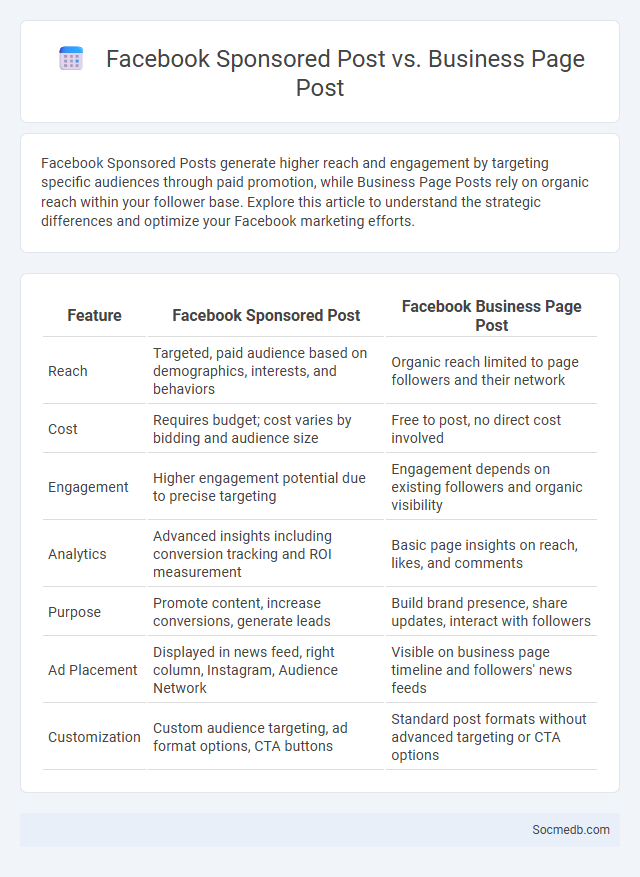
Photo illustration: Facebook Sponsored Post vs Business Page Post
Facebook Sponsored Posts generate higher reach and engagement by targeting specific audiences through paid promotion, while Business Page Posts rely on organic reach within your follower base. Explore this article to understand the strategic differences and optimize your Facebook marketing efforts.
Table of Comparison
| Feature | Facebook Sponsored Post | Facebook Business Page Post |
|---|---|---|
| Reach | Targeted, paid audience based on demographics, interests, and behaviors | Organic reach limited to page followers and their network |
| Cost | Requires budget; cost varies by bidding and audience size | Free to post, no direct cost involved |
| Engagement | Higher engagement potential due to precise targeting | Engagement depends on existing followers and organic visibility |
| Analytics | Advanced insights including conversion tracking and ROI measurement | Basic page insights on reach, likes, and comments |
| Purpose | Promote content, increase conversions, generate leads | Build brand presence, share updates, interact with followers |
| Ad Placement | Displayed in news feed, right column, Instagram, Audience Network | Visible on business page timeline and followers' news feeds |
| Customization | Custom audience targeting, ad format options, CTA buttons | Standard post formats without advanced targeting or CTA options |
Overview: Understanding Facebook Post Types
Facebook post types include status updates, photo/video uploads, links, polls, and event invitations, each designed to engage different audience preferences. Leveraging native features like Facebook Stories and live streaming boosts visibility and interaction rates by fostering real-time engagement. Businesses and individuals optimize content strategy by analyzing post performance metrics such as reach, engagement, and click-through rates to tailor future posts effectively.
What is a Facebook Business Page Post?
A Facebook Business Page Post is content shared specifically on a company's official Facebook profile designed to engage followers and promote products or services. These posts can include text, images, videos, links, or events tailored to your target audience to increase brand awareness and drive interaction. Your use of strategic keywords and compelling visuals within these posts enhances reach and boosts your business's online presence effectively.
What is a Facebook Sponsored Post?
A Facebook Sponsored Post is a paid advertisement designed to boost the visibility of your content beyond your organic audience on Facebook. These posts appear in the news feed or sidebar, targeting specific demographics, interests, or behaviors to maximize engagement and reach. Using Sponsored Posts allows your business to effectively promote products, events, or announcements to a highly tailored audience on the platform.
Key Differences: Sponsored Post vs Business Page Post
Sponsored posts on social media involve paid promotions that target specific audiences beyond your current followers to increase visibility and engagement. Business page posts are organic content shared directly with your existing followers, fostering ongoing relationships without the cost of ads. Understanding these key differences helps you optimize your marketing strategy by balancing paid reach with authentic audience interaction.
Objectives: When to Use Each Post Type
Social media post types serve distinct objectives: image posts maximize engagement through visual appeal, stories create urgency with ephemeral content ideal for time-sensitive promotions, and videos enhance brand storytelling by providing in-depth information and emotional connection. Carousel posts increase user interaction by allowing multiple images or tips in one post, perfect for product showcases or tutorials. Choosing the right post type depends on the marketing goal, whether to boost awareness, drive conversions, or maintain consistent audience engagement.
Audience Targeting Capabilities
Social media platforms offer advanced audience targeting capabilities that allow you to reach specific demographics, interests, and behaviors with precision. Leveraging tools like Facebook's Lookalike Audiences or Instagram's detailed targeting enhances campaign relevance and boosts engagement rates. Effective audience segmentation ensures your content resonates with the right users, maximizing ROI and driving brand growth.
Organic Reach vs Paid Promotion
Organic reach on social media represents the number of users who see content without paid distribution, driven by algorithmic engagement and follower interactions. Paid promotion boosts visibility through targeted ads, allowing precise audience segmentation and increased impressions beyond the organic follower base. An effective social media strategy balances organic reach and paid promotion to maximize brand exposure and user engagement.
Metrics: Measuring Performance and Engagement
Social media metrics such as reach, impressions, engagement rate, and click-through rate are essential for evaluating content performance and audience interaction. Tracking follower growth and sentiment analysis provides insights into brand reputation and community engagement. Utilizing these measurable data points helps optimize strategies to increase visibility, drive traffic, and enhance user experience.
Cost Comparison and Budget Considerations
Social media marketing costs vary widely based on platform, ad type, and targeting options, with Facebook and Instagram ads averaging $0.50 to $2.00 per click, while LinkedIn campaigns can cost up to $5.00 per click due to its professional audience. Budget considerations should include ongoing expenses such as content creation, management tools, and paid promotions, typically requiring a monthly investment ranging from $1,000 for small businesses to over $10,000 for larger enterprises. Efficient allocation focuses on maximizing ROI by analyzing cost-per-acquisition (CPA) and conversion rates to ensure spending aligns with overall marketing goals.
Best Practices for Facebook Posts and Advertising
Effective Facebook posts and advertising campaigns prioritize high-quality visuals and concise, engaging copy to capture user attention within seconds. Utilizing precise targeting options, including demographics, interests, and behaviors, maximizes ad relevance and return on investment. Consistent monitoring of performance metrics such as click-through rates, engagement levels, and conversion rates enables continuous optimization of content and ad spend.
 socmedb.com
socmedb.com